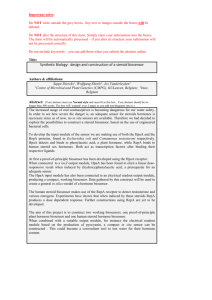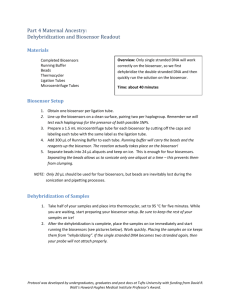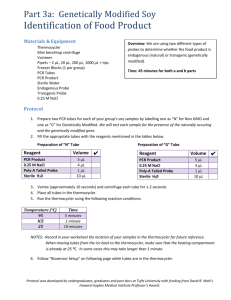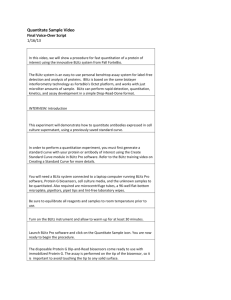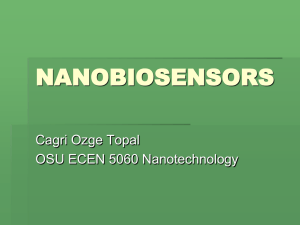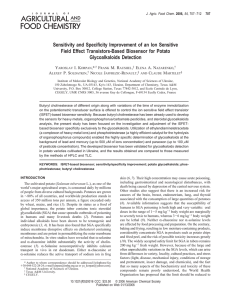2 Materials and Methods
advertisement
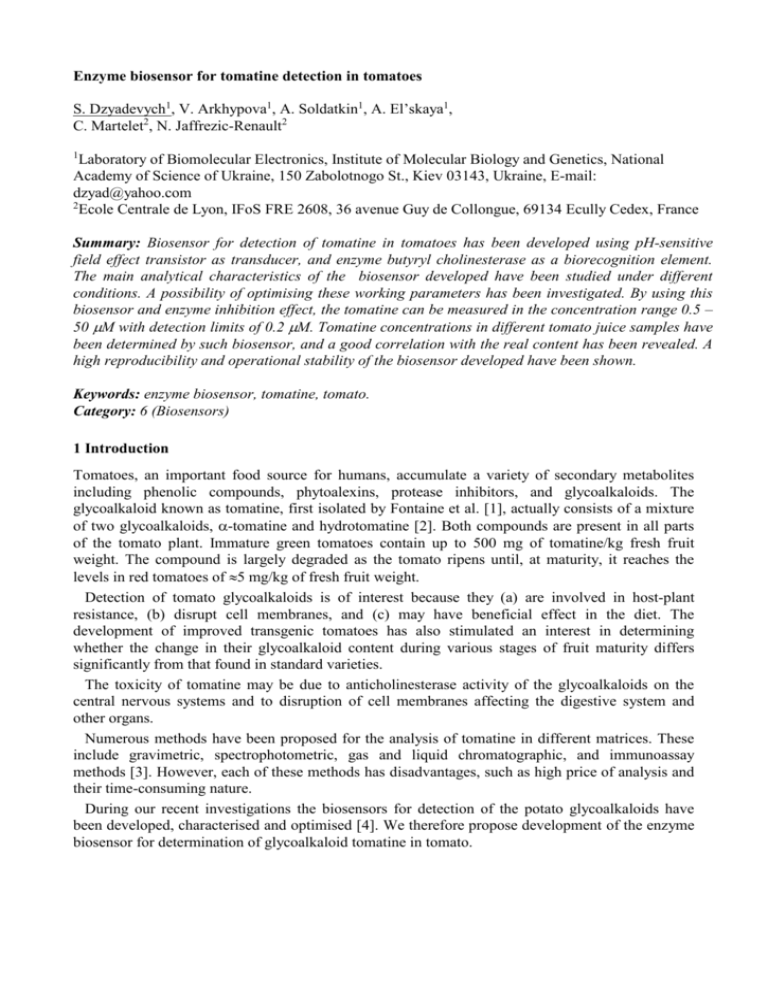
Enzyme biosensor for tomatine detection in tomatoes S. Dzyadevych1, V. Arkhypova1, A. Soldatkin1, A. El’skaya1, C. Martelet2, N. Jaffrezic-Renault2 1 Laboratory of Biomolecular Electronics, Institute of Molecular Biology and Genetics, National Academy of Science of Ukraine, 150 Zabolotnogo St., Kiev 03143, Ukraine, E-mail: dzyad@yahoo.com 2 Ecole Centrale de Lyon, IFoS FRE 2608, 36 avenue Guy de Collongue, 69134 Ecully Cedex, France Summary: Biosensor for detection of tomatine in tomatoes has been developed using pH-sensitive field effect transistor as transducer, and enzyme butyryl cholinesterase as a biorecognition element. The main analytical characteristics of the biosensor developed have been studied under different conditions. A possibility of optimising these working parameters has been investigated. By using this biosensor and enzyme inhibition effect, the tomatine can be measured in the concentration range 0.5 – 50 M with detection limits of 0.2 M. Tomatine concentrations in different tomato juice samples have been determined by such biosensor, and a good correlation with the real content has been revealed. A high reproducibility and operational stability of the biosensor developed have been shown. Keywords: enzyme biosensor, tomatine, tomato. Category: 6 (Biosensors) 1 Introduction Tomatoes, an important food source for humans, accumulate a variety of secondary metabolites including phenolic compounds, phytoalexins, protease inhibitors, and glycoalkaloids. The glycoalkaloid known as tomatine, first isolated by Fontaine et al. [1], actually consists of a mixture of two glycoalkaloids, -tomatine and hydrotomatine [2]. Both compounds are present in all parts of the tomato plant. Immature green tomatoes contain up to 500 mg of tomatine/kg fresh fruit weight. The compound is largely degraded as the tomato ripens until, at maturity, it reaches the levels in red tomatoes of 5 mg/kg of fresh fruit weight. Detection of tomato glycoalkaloids is of interest because they (a) are involved in host-plant resistance, (b) disrupt cell membranes, and (c) may have beneficial effect in the diet. The development of improved transgenic tomatoes has also stimulated an interest in determining whether the change in their glycoalkaloid content during various stages of fruit maturity differs significantly from that found in standard varieties. The toxicity of tomatine may be due to anticholinesterase activity of the glycoalkaloids on the central nervous systems and to disruption of cell membranes affecting the digestive system and other organs. Numerous methods have been proposed for the analysis of tomatine in different matrices. These include gravimetric, spectrophotometric, gas and liquid chromatographic, and immunoassay methods [3]. However, each of these methods has disadvantages, such as high price of analysis and their time-consuming nature. During our recent investigations the biosensors for detection of the potato glycoalkaloids have been developed, characterised and optimised [4]. We therefore propose development of the enzyme biosensor for determination of glycoalkaloid tomatine in tomato. 2 Materials and Methods Butyryl cholinesterase (BuChE) (EC 3.1.1.8, from horse serum) with a specific activity of 13 U/mg solid; bovine albumin, butyryl choline chloride (BuChCl), glutaraldehyde, tomatine (lycopersicine) and tomatidine were purchased from Sigma. All other reagents were of analytical grade and were used without any further treatment. The ion sensitive field effect transistors were fabricated at the Research Institute of Microdevices (Kiev, Ukraine). The potentiometric sensor chip contains identical Si3N4-ISFETs, the design and operation mode have been previously described [5]. The biologically active membranes were formed by cross-linking of BuChE with bovine albumin in a saturated glutaraldehyde vapour on the transducer surface [4]. All measurements were performed in daylight at room temperature in an open vessel filled with a vigorously stirred 5 mM phosphate buffer solution, at pH 7.2. The level of inhibition due to the action of a definite concentration of glycoalkaloids was evaluated by comparison of the biosensor response levels with and without inhibitor. 3 Results and discussion -Tomatine, a glycoside in which four carbohydrate residues are attached to the 3-OH group of the aglicon tomatidine, occurs naturally in tomatoes (Lycopersicon esculentum). Dehydrotomatine differs from -tomatine by having a double bond in ring B of the steroidal part of the molecule. In general, commercial tomatine samples consisted of the 85:15 mixture of -tomatine and dehydrotomatine. Tomatine has been shown to be a competitive inhibitor of acetyl cholinesterase following Lineweaver-Burk kinetics [3]. Also it has been previously shown that butyryl cholinesterase is more sensitive to potato glycoalkaloids than acetyl cholinesterase [4]. The resulting pH changes are produced by thet BuChE catalysed conversion of BuChCl according to the follows scheme of reaction: In order to select optimal conditions for the tomatine determination, the responses of the BuChE biosensor to BuChCl adding without and with tomatine in solution have been measured. Fig. 1 presents the calibration curve for BuChCl determination along with the dependencies of inhibition level of immobilised BuChE by tomatine on substrate concentration. The level of inhibition has been calculated as a relative decrease in the biosensor response after contact of the enzyme with the inhibitor. From this figure it is clear that the best sensitivity and accuracy of measurements have been achieved for the BuChCl concentration of about 0.5 mM. It has been also shown that inhibition does not depend on duration of the biosensor contact with glycoalkaloids. 1 40 30 30 20 20 2 10 Inhibition level, % Response, mV 40 10 0 0 2 4 6 8 BuChCl, mM Fig. 1. Calibration curve biosensor for BuChCl determination (1), and dependence of inhibition level on substrate concentration for 10 M tomatine (2) in 5 mM phosphate buffer, pH 7.5. The main analytical characteristics of biosensor for the glycoalkaloids determination were studied under different conditions. A possibility to optimise these working parameters was investigated. An influence of various factors on the sensitivity, the limit of detection, the dynamic range, and the operational and storage stability was investigated. Also, the series of experiments were performed to study an effect of different procedures of sample pre-treatment on the sensor response. Fig.2 presents the calibration curves for the detection of tomato glycoalkaloids. As it can be seen, the tomatine can be detected within the range of 0.5 – 50 M with detection limits of 0.2 M. The dynamic ranges show that such biosensors are suitable for a quantitative detection of tomatine in tomato samples. 1 Inhibition level, % 70 60 50 40 30 2 20 10 0 1 10 100 Tomato glycoalkaloids, M Fig. 2. Calibration curves for the detection of tomatine (1) and tomatidine (2). Two biosensor methods of tomatine determination in juice samples from different commercial variety of tomato were compared: method of standard additions and with using calibration curve. Harvested tubers, cleaned manually by gentle washing under running water, were grated and passed through a simple sieve to obtain the juices. The samples were analysed directly using the biosensor. The total tomatine contents in tomato were obtained in the range of 35 - 70 mg/kg of fresh weight. A high reproducibility and operational stability of the biosensor developed have been shown. References [1] T.D. Fontaine, G.W. Irving, et al. Isolation and partial characterization of cristalline tomatine, an antibiotic agent form the tomato plant. Arch. Biochem. 18 (1948) 467-475. [2] M. Friedman, C.E. Levin, G.M. McDonald. -Tomatine determination in tomatoes by HPLC using pulsed amperometric detection. J. Agric. Food Chem. 42 (1994) 1959-1964. [3] M. Friedman. Tomato glycoalkaloids: role in the plant and in the diet. J. Agric. Food Chem. 50 (2002) 5751-5780. [4] V.N. Arkhypova, S.V. Dzyadevych, et al. Development and optimisation of biosensors based on pH-sensitive field effect transistors and cholinesterases for sensitive detection of solanaceous glycoalkaloids. Biosensors Bioelectron. 18 (2003) in press. [5] A.A. Shul’ga, L.I. Netchiporouk, et al. Operation of an ISFET with non-insulated substrate directly exposed to the solution. Sens. Actuators B 30 (1995) 101-105.


